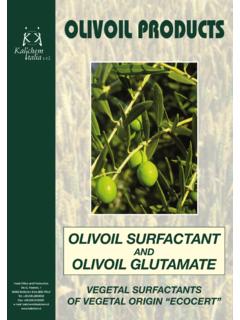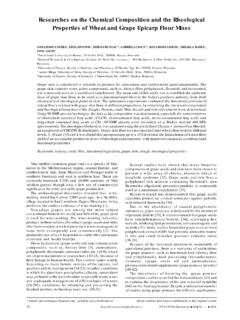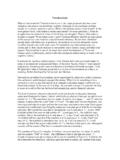Transcription of THINK About It - Jones & Bartlett Learning
1 Suto Norbert Zsolt/ShutterStock, About It 1 Your friend warns you that eating some foods together is not healthful. Is this likely to change your eating behavior? 2 How good are you at identifying tastes? 3 Have you ever noticed that food sometimes tastes sweeter after chewing it for a while? 4 You feel particularly happy and you nd that a meal prepared by your friend tastes especially good. Any connection? Learning Objectives Sequence the steps for digestion of food and absorption of nutrients through the digestive system. Explain the role of enzymes in digestion.
2 Explain how nutrients are circulated through and eliminated from the body. Identify factors that in uence digestion, absorption, and nutrient transport in the body. Examine common nutritional and digestive system disorders for their root causes. Visit Chapter 3 Digestion and Absorption 10522/02/13 1:02 PM Jones & Bartlett Learning , LLC. NOT FOR SALE OR DISTRIBUTION Jones & Bartlett Learning , LLC. NOT FOR SALE OR DISTRIBUTION The aroma of a roasting turkey fl oats past your nose. You haven t eaten for six or seven hours.
3 Anticipating a delicious experience, your mouth waters, and your digestive juices are turned on. Is this virtual reality? Not at all! Before you eat a morsel of food, fl eeting thoughts from your brain signal your body to prepare for the feast to come. The body s machinery to process food and turn it into nutrients is not only effi cient but elegant. The action unfolds in the digestive tract in two stages: digestion the breaking apart of foods into smaller and smaller units and absorption the movement of those small units from the gut into the bloodstream or lymphatic system for circulation.
4 Your digestive system is designed to digest carbohydrates, proteins, and fats simultaneously, while at the same time preparing other substances vitamins, minerals, and cholesterol, for example for absorption. Remarkably, your digestive system doesn t need any help! Despite promotions for enzyme supplements and diet books that recommend consuming food or nutrient groups separately, scientifi c research does not support these claims. Unless you have a specifi c medical condition, your digestive system is ready, willing, and able to digest and absorb the foods you eat, in whatever combination you eat them.
5 But go back to the aroma of that roast turkey for a moment. Before we begin digesting and absorbing, our senses of taste and smell fi rst attract us to foods we are likely to consume. Taste and Smell: The Beginnings of Our Food Experience You probably wouldn t eat a food if it didn t appeal in some way to your senses. Smell and taste belong to our chemical sensing system, or the chemo-senses . The complicated processes of smelling and tasting begin when tiny molecules released by the substances around us bind to receptors on special cells in the nose, mouth, or throat.
6 These special sensory cells transmit mes-sages through nerves to the brain, where specifi c smells or tastes are identifi ed. The Chemosenses Olfactory (smell) cells are stimulated by the odors around us, such as the fragrance of a gardenia or the smell of bread baking. These nerve cells are found in a small patch of tissue high inside the nose, and they connect directly to the brain. Gustatory (taste) cells react to food and beverages. These surface cells in the mouth send taste information along their nerve fi bers to the brain. The taste cells are clustered in the taste buds of the mouth and throat.
7 Many of the visible small bumps on the tongue contain taste buds. A third chemosensory mechanism, the common chemical sense , contributes to our senses of smell and taste. In this system, thousands of nerve endings especially on the moist surfaces of the eyes, nose, mouth, and throat give rise to sensations such as the sting of ammonia, the cool-ness of menthol, and the irritation of chili peppers. In the mouth, along with texture, temperature, and the sensations from the common chemical sense, tastes combine with odors to produce a perception of fl avor.
8 Flavor lets us know whether we are eating a pear or an apple. You recognize fl avors mainly through the sense of smell. If you hold your nose while eating chocolate, for example, you will have trouble identifying it even though you can distinguish the food s sweet-ness or bitterness. That s because the familiar fl avor of chocolate is sensed largely by odor, as is the well-known fl avor of coffee. digestion The process of transforming the foods we eat into units for absorption. absorption The movement of substances into or across tissues; in particular, the passage of nutrients and other substances into the walls of the gastrointestinal tract and then into the [key-mo-SEN-sez] The chemical sensing system in the body, including taste and smell.
9 Sensory cells in the nose, mouth, or throat transmit messages through nerves to the brain, where smells and tastes are identifi cells Nerve cells in a small patch of tissue high in the nose connected directly to the brain to transmit messages About specifi c smells. Also called smell cells Surface cells in the throat and on the taste buds in the mouth that transmit taste information. Also called taste chemical sense A chemosensory mechanism that contributes to our senses of smell and taste. It comprises thousands of nerve endings, especially on the moist surfaces of the eyes, nose, mouth, and 2 Jupiterimages/Creatas/Thinkstock106 Chapter 3 Digestion AnD 10622/02/13 1:02 PM Jones & Bartlett Learning , LLC.
10 NOT FOR SALE OR DISTRIBUTION Jones & Bartlett Learning , LLC. NOT FOR SALE OR DISTRIBUTION Until recently, it has been suggested that dietary fat has no taste and that its appeal is solely because of its texture. However, this might not be the case. A number of studies have found a taste receptor for fat, and that essential fatty acids (fatty acids that must be obtained from the diet) elicit the stron-gest taste response. 1 The sight, smell, thought, taste, and in some cases even the sound of food can trigger a set of physiologic responses known as the cephalic phase responses.

















